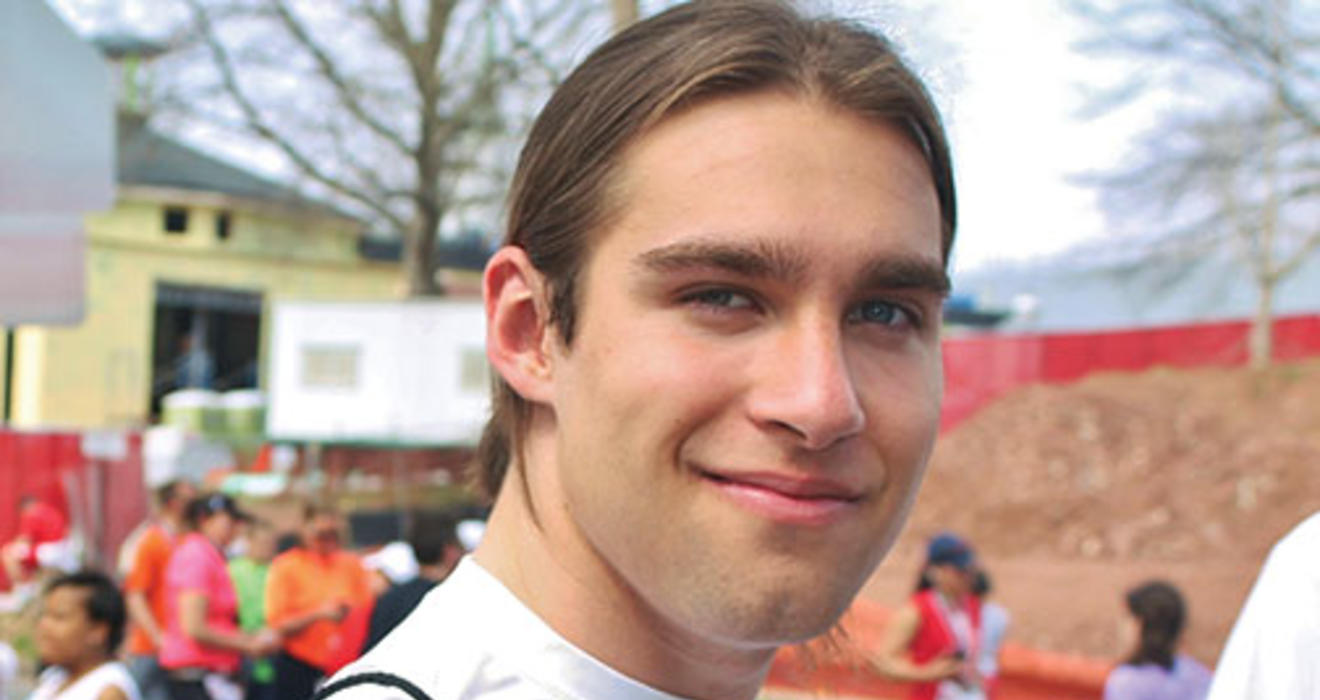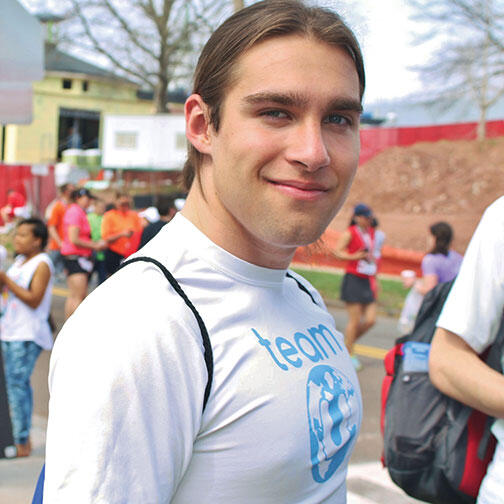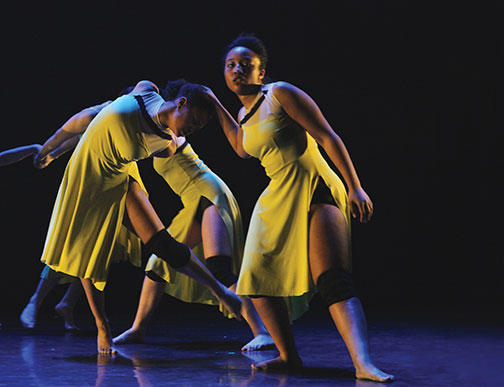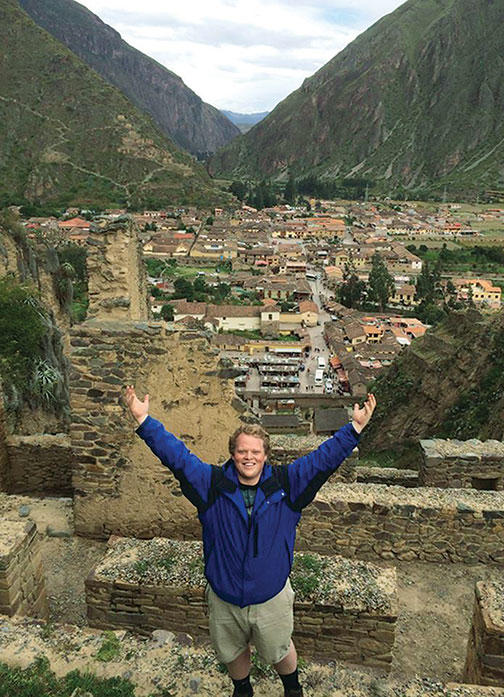
Thomas Ray Garcia ’16 dreamed of leaving Texas for college.
He had lived his entire life in the Rio Grande Valley, barely a 20-minute drive from the Mexican border. But few students at his public high school ventured beyond the Lone Star State, and Garcia’s guidance counselor, responsible for the hopes of more than 500 students, was skeptical. So Garcia turned to Google and typed “great schools for liberal arts.” The results brought up a school he’d never heard of: Princeton University.
Garcia’s mother had encouraged her son to dream big; as a teenager she had received a scholarship to fashion school in New York but remained in Texas to support her parents, both Mexican immigrants. Taking her advice to heart, Garcia began researching schools in his freshman year of high school, almost entirely on his own. He read up on universities and financial-aid packages (“it was a bit unbelievable how great Princeton’s financial aid was”) and stumbled upon SAT deadlines just in time. In the end, he applied to seven schools — five outside Texas — and was “ecstatic” when Princeton’s acceptance letter arrived.
“I knew I wanted to learn, but I wasn’t knowledgeable enough to ask the questions that would have really transformed my experience in the class.”
Thomas Ray Garcia ’16
Arriving at Princeton, Garcia had few worries, “mostly because I didn’t know what to expect.” An aspiring novelist who employs long-distance runs to build body and mind, he quickly joined writing groups, public-speaking practice sessions, and mentoring programs for high school students. But classes were a struggle. He had excelled in the advanced courses offered at his high school, but he still felt unprepared for college. In Latin he was one of the few coming to the language cold. In English he scrambled to read Heart of Darkness one week, Pale Fire the next. “I felt like I was way too behind in comparison to my peers.” He enrolled in a class on classical Greek history, but he rarely spoke. “I knew I wanted to learn,” he says, “but I wasn’t knowledgeable enough to ask the questions that would have really transformed my experience in the class.”
His time was consumed with studying, sometimes 50 hours or more a week. He would call home to Texas, but had trouble articulating to his mother why he was struggling. He attended a few tutoring sessions offered by Princeton’s Writing Center, but came away feeling that he needed to grapple with more fundamental challenges. “In high school, learning was just a means to an end,” Garcia says, but he saw how passionate his professors were when they discussed their work. He worked to develop his own passion for the process: “I really pushed myself — [I was] looking for deeper meaning, and a love of learning.”
Garcia is one of roughly 600 “first-generation” undergraduates at Princeton — students whose parents never attended or completed college — more than 11 percent of the student body. They hail from the inner cities of California, the suburbs of Chicago, and small towns in South Carolina. They attended large public high schools and small private prep schools. Some were raised by single parents, others in two-parent homes. They are the children of immigrants and those who have been in America for generations. They are Asian, Hispanic, black, white.
Among the most famous first-gen students of our time is first lady Michelle Obama ’85 (Supreme Court Justice Sonia Sotomayor ’76 is another), who has helped jump-start a national conversation about increasing access and graduation rates for low-income and first-generation students. Last January, President Eisgruber ’83 was among 80 college leaders at a White House meeting where Obama discussed her experience at Princeton and the difference it has made in her life.
First-gen students make up about 30 percent of America’s postsecondary students, and a much smaller percentage at the nation’s most selective schools. A 2013 study by researchers at Harvard and Stanford universities showed that a disproportionate number of high-achieving, low-income students (including many first-gen students) never apply to top schools, for reasons that include a lack of confidence and limited access to information about colleges and the application process. That is despite generous financial aid that can make Princeton and other elite schools more affordable than state universities.
Princeton has been striving to find first-gen students, partnering with nonprofits like QuestBridge and Leadership Enterprise for a Diverse America (LEDA), which coach selected students through the application process and try to match them with elite universities, says Dean of Admission Janet Rapelye. It also identifies and connects with students and community organizations around the country through College Greenlight, an online service that allows institutions to search for potential applicants using criteria beyond test scores and grades.
But getting these students to apply is not the only concern, and universities are focusing more attention on first-generation students after they arrive on campus. Bridget Terry Long ’95, academic dean at the Harvard Graduate School of Education, studies the experience of first-generation and low-income students at universities. She says that even among students who score high on the SAT, there is a wide discrepancy in graduation rates between first-generation and low-income students and their more advantaged peers, though the difference narrows considerably at the most elite institutions, which have the resources to offer more support. Princeton says that 97 percent of all students graduate within six years, but that it does not specifically track the completion rate for first-gen students. A Princeton committee on socioeconomic diversity reported in September that low-income students — among them, many first-generation students — ultimately succeed on campus, but are more likely to forgo some activities and feel less accepted (see PAW, Oct. 22, 2014).
“Princeton does a really good job with their financial-aid program, and that opens it up for a lot more students to attend,” says Tennille Haynes, director of the Carl A. Fields Center for Equality and Cultural Understanding, which promotes cultural and social diversity and for decades has tried to help minority students feel at home at Princeton. “But with that comes a great responsibility of figuring out how to support these students on campus.” Long notes that not only do students need to know how to navigate a system, they need to know how to advocate for themselves and “when to speak up, when to ask for help.”
The Princeton social scene was “a huge culture shock.”
Tula Strong ’15
Supporting first-generation students starts with broadening the definition of what college costs, Long says — but it does not end there. Financial aid, she believes, should not be limited to tuition or books, but should ensure that students can build connections and networks and “really participate in the social life of the university.” To that end, Princeton covers a portion of eating-club expenses in its financial-aid package, provides funds to cover low-income students’ medical expenses and school supplies, and offers grants for students to study abroad.
When the mother of Dallas Nan ’16 developed complications from heart surgery during his freshman year, an attentive administrator told him about a University emergency fund, which paid for a plane ticket home to Boise, Idaho. Nan had been unable to think of anything but his mother, and he could not afford a visit himself. The help, he says, “meant the world to me.”
But it took almost a year for Nan to feel at home at Princeton. A once-confident student who had excelled in high school despite having been homeless for a few months as a child, Nan was wracked with doubt in college. He kept to the “safe haven” of his room, fretting that he did not deserve to be at Princeton. Then, in the spring of his freshman year, he met a student who was kindhearted and a great listener. “From that point on,” Nan says, “I had the confidence and ability to fully blossom and access my potential.”
“A lot of us first-generation students don’t have anyone to talk to about what we are going through at Princeton,” says Vicky Quevedo ’15, who came from a small college-readiness charter school in downtown Los Angeles. “I could call up my mom or dad. But they can’t understand. They’ve never even visited the campus.”
To be sure, the experiences of first-generation students — like those of other students — vary immensely. Shawon Jackson ’15 came to Princeton from a private boarding school focused on science and technology, and describes a very smooth transition to college. He’s now in his second term as president of the Undergraduate Student Government.
Some first-gen students, particularly those from minority and low socioeconomic backgrounds, have found Princeton’s social scene the most challenging aspect of campus life. When Quevedo settled into college life, she felt she was defined solely as a Latina. In her sophomore year, she was shocked to realize she had no friends who were not minorities, first-generation, or from low-income households.
Hoping to make friends outside the Latino community, she rushed a sorority; there, too, she sensed segregation. When it came time to be matched with a “big sister,” she was paired with one of the chapter’s only black members; when she was assigned a “little sister,” it was one of the few Latinas. She left the sorority after a year and a half.
“I wanted to create a community where students from diverse backgrounds would feel welcome and wouldn’t have to question their identity,” she explains. Quevedo has gone on to become president of Latinos y Amigos, a pan-Latino campus group; a program leader for the Community House Crossings program, which teaches social activism; and a dancer in an urban Latin dance group.
Quevedo’s friend Tula Strong ’15, a first-gen student who had attended a public school east of Los Angeles, experienced a similar disconnect. Strong was raised primarily by her mother, who fled the Liberian civil war as a young woman, and who made it clear that she expected her daughter to attend college. At Princeton, she thrived academically, majoring in comparative literature and winning Lewis Center awards for her work in dance, in which she is earning a certificate. She made her mark, too, as a student leader, as a peer adviser at Butler College and co-founder of Princeton Gates Millennium Scholars, which connects student winners of the scholarship. Still, Strong has found the Princeton social scene to be “a huge culture shock,” with few peers she could relate to. Her childhood friends were attending community colleges or held down full-time jobs; some were married, others were single mothers. At Princeton, Strong found that most of her friends were other minority or first-generation students. “I walk through campus, and I feel like I don’t see diverse faces,” she says. “It would be nice to look through a crowd and see many people who are light skinned, dark skinned, curvy, thicker.”
She joined Quadrangle Club as a junior, but as a senior chose to go independent. Despite the increased financial support offered by the University, Strong found that neither she nor many of her friends felt socially comfortable at the clubs.
“I want to make students feel comfortable sooner, not let them miss these life-altering opportunities.”
Dallas Nan ’16
Cynthia Cherrey, vice president for campus life and a first-generation student herself, believes that one of Princeton’s biggest challenges is ensuring that “every student, no matter where they came from or how they got here, knows that they belong at Princeton.” Last month the University announced that it is improving its 20-year-old Freshman Scholars Institute (FSI), an optional, invitation-only summer program intended to ease the transition from high school to Princeton. (Last summer, 80 students took part.) In recent years, the pre-frosh have taken a humanities survey course and a quantitative-reasoning course; soon there will be new tracks in life sciences and engineering, including lab experience — all with the goal of reducing attrition among students who are interested in those fields. Other new programs are being phased in as well: workshops for students taking freshman chemistry, and a lab-based summer research program for FSI alumni.
When not in class, FSI students receive academic tutoring, participate in dinners with faculty, and make occasional outings to cultural spots such as the Bronx Zoo. Associate Dean of the College and FSI Director Diane McKay says she hopes that in seven intense weeks, “students have developed a sense of confidence about their capacity to recognize and respond to the academic and social challenges presented by the first year of college.”
In trying to better support all first-generation and low-income students, Princeton is employing a variety of strategies. The Fields Center emailed all members of the Class of 2018, encouraging them to connect with 40 upper-class mentors and to meet during the year over ice cream, study breaks, coffee, and meals.
In 2012, psychologist Jonathan Pastor, associate director of counseling and psychological services at Princeton, created a support group for first-gen students to discuss their concerns about finances, situations at home, and feelings of isolation. Pastor says he wanted to provide a space where the students could meet others confronting similar issues — and where they could become aware of available assistance. Six or seven students participate, a number that is typical of University discussion and support groups.
Grateful as they are for University programs, many first-gen students felt that more needed to be done. In March, some of the students traveled to Amherst College to attend the second annual First-Generation College Student Summit, where they learned of efforts at other universities, such as Harvard’s new first-gen alumni mentoring program. Then, in the fall, students launched the Princeton Hidden Minorities Council (PHMC) to build and support a vibrant first-generation and low-income community on campus. Nan, who co-chairs the PHMC, is using his own doubt-ridden and lonely freshman year as inspiration. “I want to make [students] feel comfortable sooner, not let them miss these life-altering opportunities,” he says. Co-chair Brittney Watkins ’16 says she hopes the group shows students “that they are not alone.”
PHMC has created a website listing resources and events of interest to all undergraduates, not just first-generation students. As of October, more than 200 people were on the group’s mailing list, and the students were planning a series of parties, study breaks, panels, and performances to raise awareness and spark dialogue. This September they hosted a dinner for first-gen students with Cherrey and Dean of the College Valerie Smith.
The PHMC website also celebrates the stories of faculty, staff, and students who are first-generation or low-income. Farrah Bui ’14, who works in human resources at Google, describes how empowering it was to learn that Cherrey shared a similar first-gen background. Bui is the daughter of Vietnamese refugees and grew up in a tiny town in South Carolina, and at first had tried to hide her first-generation identity. “I was afraid that people wouldn’t view me the same, that they wouldn’t want to hang out with me. I wanted to be accepted and seem cool, and I thought that part of me was very uncool,” she says. “Having a role model like Cherrey on campus — an example of someone who was very successful — really meant a lot to me. I suddenly felt that I wasn’t necessarily at a disadvantage.”
PHMC hopes to engage the whole student body in a conversation so all students — including wealthy students — can gain important new perspectives. “Sometimes when you come from wealthier communities, it could be that you’ve never interacted before with someone who is first-generation or from a low socioeconomic background,” Nan says. “Understanding leads to acceptance.” No longer the lonely freshman introvert, Nan has become a chemical-engineering major with hopes of going into industry and then politics, a member of Terrace Club, a tutor to Trenton middle-school students, and a campus leader who serves in undergraduate government and on Princeton’s Honor Committee.
And while Garcia has found his place at Princeton, he has not forgotten his home or his rocky college transition. On campus, the English major and creative-writing student now blogs for the admission office, and has been a key player in designing PHMC’s new website. But perhaps his most significant work is back home in Texas, where he has co-founded a summer college-mentoring program for high school students in the Rio Grande Valley. More than 50 students participated last summer, its second year of operation.
Garcia hopes it will continue to grow. He sees it as his way to give back. “I didn’t realize how big the inequality was until I went to Princeton,” he says, “and then came home to the real world.”
Jessica Lander ’10 is a graduate student, freelance writer, and author of Driving Backwards, a nonfiction portrait of small-town New Hampshire.









1 Response
Peter B. Lowry ’63
9 Years AgoWhen College Wasn’t a Necessity
“First in the Family” (feature, Dec. 3) was interesting, but hardly “new” news. I am 73 years old, having graduated in 1963, and I was the first in my family to go to college. My father and my grandfathers were successful in New York City business – none went to college. My father refused, as he had been going to boarding school for some six years and was sick of it! For them, it wasn’t a necessity – possibly the same for me, but certainly mandatory in more recent years. And so it goes. May the farce be with you ... it’s our only hope.